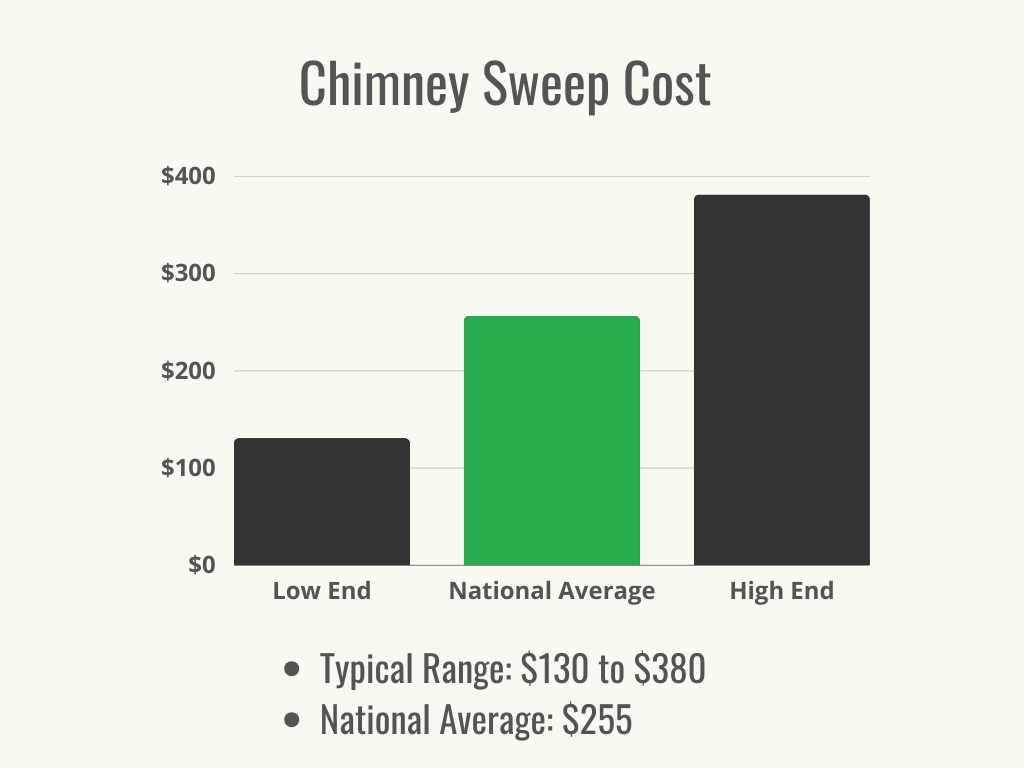

We may earn revenue from the products available on this page and participate in affiliate programs. Learn More ›
Highlights
- The typical range for chimney sweep costs is $130 to $380, with a national average of $255.
- Some of the factors for calculating chimney sweep costs include the fireplace type, chimney accessibility, cleaning frequency, usage frequency, chimney cleaning method, geographic location, and seasonality.
- Some of the biggest benefits of chimney sweeping include safety, heating efficiency, easier inspections, cost savings, and a longer-lasting chimney.
- Chimney sweeping is best left to trained professionals who will be able to perform the job safely as well as identify any chimney issues.
Wood-burning fireplaces are cozy amenities that appeal to many homeowners and home buyers, and fireplaces may even help save money on heating costs. Like anything else that gets a lot of use, though, a fireplace needs regular maintenance. As wood burns, it leaves soot and creosote (an oily byproduct of wood fires) on the chimney walls. These can build up and pose fire and health hazards. According to Angi, the best chimney cleaning services typically charge between $130 and $380, and the national average cost of a chimney sweep is $255.
Periodic inspections and cleaning are necessary to protect the home and keep fireplaces operating efficiently. While the National Fire Protection Association recommends at least one annual cleaning, the frequency of cleaning ultimately depends on usage. The chimney sweep—the person who performs the cleaning—will inspect and evaluate the chimney to determine when it needs cleaning. There are several factors that determine chimney sweep cost and help homeowners decide if and when to schedule a chimney sweep.
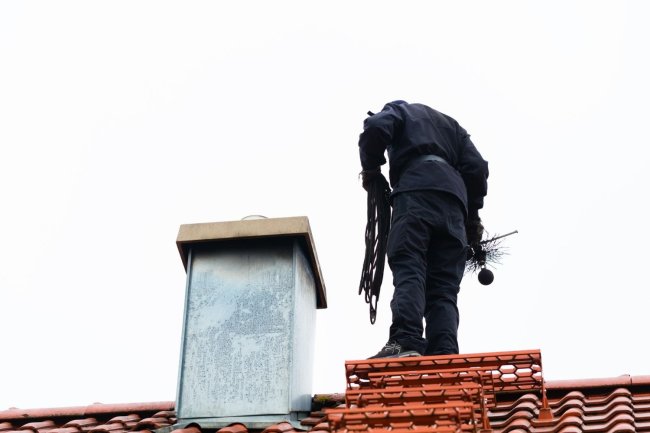
Factors in Calculating Chimney Sweep Cost
How much does a chimney sweep cost? The national average cost for chimney cleaning is $255. However, several elements determine the final chimney cleaning cost. If it’s been a while since the chimney was cleaned, it’s likely to need more work, which will raise the price, especially if the fireplace is used often. Accessibility can also affect the price; steeply pitched roofs make the job more complex and more dangerous. The cost will go up if the work goes beyond cleaning to repair, such as installing a chimney cap or damper, fixing the flashing, or removing an animal or other debris.
Sometimes the inspection cost is extra, particularly if the chimney has suffered structural damage or if a new component is being retrofitted. Some companies charge by the hour, while others offer a flat rate and may even have package deals that include inspection and sweeping.
Fireplace Type
Various types of fireplaces have different types of chimneys, which may require different methods of cleaning. The most common types of fireplaces are gas, pellet, wood-burning, and wood. Gas fireplace chimneys are often the cheapest to clean at around $85 to $250, and some gas fireplaces don’t have chimneys at all. Wood-burning fireplaces have some of the highest chimney sweep costs at $300 to $1,000.
Chimney Accessibility
Roofs with acutely high peaks or steep pitches make access to the chimney more difficult and dangerous, leading to higher costs. If the chimney sweep has difficulty reaching the chimney by ladder or safely getting to the chimney, the cost to clean it can go up.
Cleaning Frequency
If the fireplace is used regularly but not cleaned annually, the cost of a chimney sweep could be as high as $800, according to HomeAdvisor. Removing the buildup that has accumulated and solidified over some years isn’t easy. If chimney sweeping has been neglected, it’s likely to take extensive work to clean it. That could involve multiple sessions to remove layers of soot.
Usage Frequency
If the fireplace isn’t used often, it may be possible to extend the period between cleanings because there won’t be much soot buildup. However, if the fireplace is in use more than four times a week, it may need a more thorough or more frequent cleaning to keep it functioning safely and efficiently.
Chimney Cleaning Method
According to Russ Dimmitt, director of education for the Chimney Safety Institute of America (CSIA), “There are two methods commonly used in chimney sweeping. The first is manually sweeping the flue using rods and brushes. This method is the less common of the two. Most chimney professionals use rotary sweeping tools powered by a drill. The rotary method is preferred as it provides a more thorough sweeping. Either method necessitates dust control measures; typically a special vacuum system is used to control dust. Many chimneys can now be swept from below with rotary methods.” The technique won’t significantly affect the cost, but it’s worth it for homeowners to know which method will be used to prepare the home accordingly.
Geographic Location
Chimney sweeping prices can differ depending on the home’s geographic location, with urban locations generally coming in at a higher price than rural areas where the cost of living is lower. Demand can also raise the price, so homeowners in neighborhoods where chimneys are a common home feature may end up paying more. Homeowners who have houses in remote areas may also incur a travel fee. For reference, average costs in New Jersey are relatively high at $550, whereas in Florida prices are closer to $250 on average. Homeowners can look up “Chimney sweep in my area” to get a sense of local chimney sweep prices.
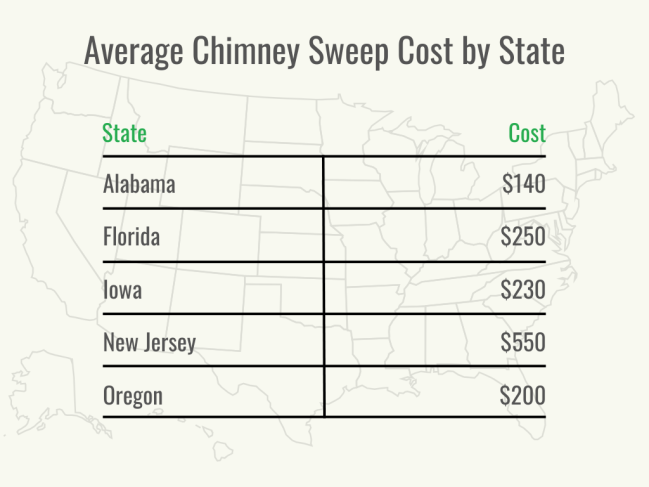
Seasonality
Dimmitt advises that the best time to hire a chimney sweep is in the late summer or early fall. “As cooler weather approaches, chimney professionals are booked out for extended periods of time: usually weeks, and sometimes months. By having chimney inspections performed in the warmer weather months, a homeowner can receive more timely service and have sufficient time to make any necessary repairs before heating season arrives.”
Some companies offer discounts for work done in the spring and summer off-season. By spreading out their work year-round, they’re better able to serve their customers. Of course, homeowners who are experiencing any issues with their fireplaces or who notice any signs of potential problems will want to find a local chimney sweep right away by looking up “chimney companies near me.”
Additional Costs and Considerations
While most chimney sweeping jobs cost around $255, there are a few factors that can cause the cost to be higher than the national average. If any damage is discovered during the process, homeowners may need to pay some additional repair costs.
Chimney Inspection
Chimney inspection costs typically correlate to the three levels of inspection. Level 1 is often included in the cleaning price, which is around $85 to $950 for both services. It’s a basic inspection for chimneys that are in good repair and regularly cleaned. It involves a visual check of the condition of the exterior and the fireplace components and whatever can be seen of the interior using a flashlight.
Level 2 inspections increase in cost and complexity and range from. This inspection might be required before making structural repairs, relining the flue, or retrofitting another style of heating component. The process consists of video scanning the interior surface to make a detailed assessment. It costs $150 to $1,000 to have a level 2 inspection done at the time of cleaning.
The most expensive inspection is Level 3, and this type is performed if structural damage has already occurred. Level 3 inspection and cleaning costs $500 to $5,000 because portions of the chimney may have to be deconstructed to examine the extent of the damage.
| Inspection Level | Average Cost (Including Cleaning) |
| Level 1 | $85 to $950 |
| Level 2 | $150 to $1,000 |
| Level 3 | $500 to $5,000 |
Chimney Cap Installation
Cleaning and inspection may uncover that the chimney cap is damaged or missing and needs to be replaced. The chimney cap is a screened cap that fits over the top of the chimney and is attached to the chimney liner or flue tile. It allows smoke and gases to escape but prevents snow, rain, debris, and animals from getting in. Not only does the chimney cap help prevent downdrafts but it also prevents chimney damage from freeze-thaw cycles. A new chimney cap installation can cost anywhere from $75 to $1,000, but the average price is $300.
Chimney Flashing Installation
Flashing is an L-shaped piece of sheet metal inserted where the chimney abuts the roof. Its purpose is to prevent leaks and water damage by diverting water from the chimney. Without it, water can get between the chimney and the roof and even get into the house. A chimney sweep will see if the flashing is damaged during a routine cleaning or inspection and can repair it, but there will likely be an extra fee. Typical flashing installation costs $200 to $500.
Chimney Liner Installation
Chimney liners (or flue liners) are made of clay, ceramic, or metal and protect bricks and mortar from heat and corrosion to extend the chimney’s life and make fireplace use safer. They also protect the house from dangerous heat transfer, and they assist in optimized efficiency and ventilation.
Chimney liner installation costs range from $2,500 to $7,000. Cast-in-place liners are more expensive but provide optimal insulation. A chimney sweep may repair a slightly damaged liner, but more extensive damage will likely require a full replacement.
Fireplace Damper Installation
Dampers are small flaps opened when a fire is lit to help guide smoke up and out of the chimney. They also assist in preventing downdrafts. A damaged or warped damper can either allow smoke into the house or pull indoor air out. Typical costs are $200 to $400 to install or $100 to $225 to repair, depending on the extent of the damage.
Animal Removal
Animals and birds sometimes take up residence in the fireplace. Depending on the species, the number of animals, and the difficulty in removing them, professional (and humane) removal can cost $200 to $600. If repairs are needed once the animals are out, the cost can go up. Animals commonly found in fireplaces include bats, birds, squirrels, and raccoons. If there is a dead animal in the fireplace, it’s best for the homeowner to call a wildlife trap and removal service like Critter Control.
Creosote Logs
Burning creosote logs can help loosen up to 60 percent of residue in the flue by chemically changing the oily creosote into a flaky consistency that falls into the fireplace. Most cost $16 to $25 per log. However, debris can still get stuck if a chimney is slanted, and if it drops into a fire in the fireplace, the creosote could cause a chimney fire. While creosote logs can help clear debris between cleanings, they are not a replacement for a chimney sweep.
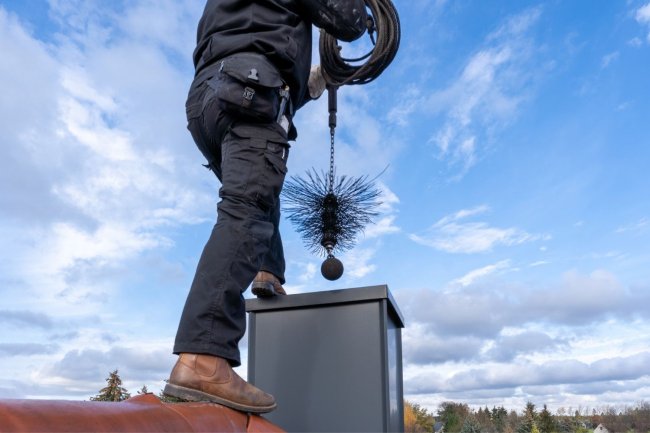
Chimney Sweep Cost by Type of Fireplace
Costs for chimney sweeping can depend on the type of fireplace. The most common fireplaces are gas fireplaces, pellet stoves, wood-burning fireplaces, and wood stoves.
| Type of Fireplace | Average Chimney Sweep Cost |
| Gas fireplace | $85 to $250 |
| Pellet stove | $175 to $350 |
| Wood-burning fireplace | $300 to $1,000 |
| Wood stove | $200 to $500 |
Gas Fireplace
Gas fireplaces are popular due to their relatively low cost, energy efficiency, and easy maintenance. Since they do not use logs or produce smoke, gas fireplaces need less frequent maintenance than other types and may only require cleaning every 1 to 2 years. Some gas fireplaces use venting systems rather than chimneys, but for those that do include a chimney, sweeping costs between $85 and $250.
Pellet Stove
Pellet stoves are compact, efficient fireplaces that burn compressed pellets made out of recycled materials rather than wood logs. While the pellet’s fireplace must be cleaned every week, chimney sweeping is needed less frequently and costs about $175 to $350.
Wood-Burning Fireplace
A classic wood-burning fireplace is desirable for the ambience it creates, but it is also the most costly to sweep. This is due to the buildup of creosote, which is produced when wood is burned and can build up on the walls of the chimney. Without regular removal, this buildup can become a fire hazard. A wood-burning fireplace sweep costs $300 to $1,000.
Wood Stove
A wood stove is a small and efficient alternative to a built-in fireplace. Like wood-burning fireplaces, wood stoves are subject to creosote buildup and must be swept at least annually. Homeowners can expect to pay $200 to $500 for a wood stove chimney sweep.
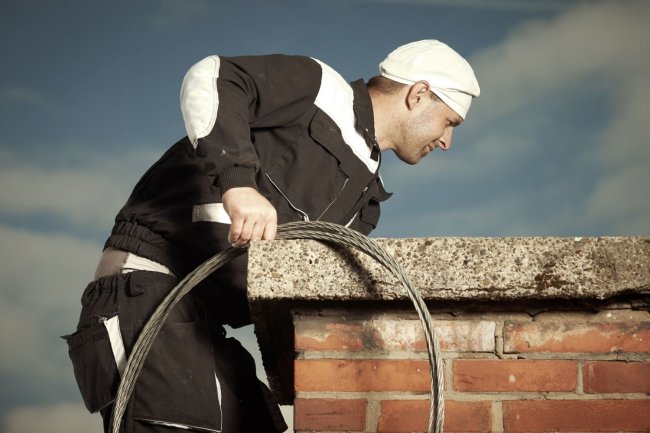
Do I need a chimney sweep?
Without routine inspections, cleanings, and necessary repairs, a chimney can fail, putting everyone in the home at risk. Faulty chimneys can trap toxic gases like carbon monoxide in the house. Chimney fires can burn up to 2,000 degrees Fahrenheit, and this intense heat can cause structural damage, spread to the rest of the home, or even cause a chimney to explode if chimney maintenance has been neglected.
Beyond safety concerns, a fireplace that hasn’t been cleaned in a long time doesn’t operate efficiently. Regular cleanings can also warn of any repairs or other serious issues needing attention before they become an emergency.
Advised Frequency of Cleaning
According to Dimmitt, “The National Fire Protection Association states that chimneys, fireplaces, and vents [should] be inspected at least annually, and cleaning, maintenance, and repairs shall be done if necessary.” With heavy usage or indications of an issue, like odor or smoke coming into the home, more frequent attention may be necessary. It’s also a good idea for homeowners to get more frequent cleanings if more than two cords of wood or 36 fires are burned in the fireplace in a year, or if the wood that is used is treated or green.
Elapsed Time Since Last Cleaning
If the fireplace has not been cleaned in a few years, it’s likely to have a considerable buildup of tar, soot, and debris. This will probably make it more difficult to clean as well as more expensive. It’s even possible that more than one cleaning will be necessary to remove creosote buildup altogether.
Odors
Odor can indicate a variety of issues with the fireplace or chimney. The smell of tar can indicate creosote buildup. Unpleasant smells may stem from gases trapped in the home by a blocked chimney. They could also indicate water in the firebox, a rusty damper, or mold. Another cause of foul odor may be decaying debris, such as leaves or dead animals stuck in the chimney.
Fire Quality
A weak fire indicates the need for a chimney cleaning—and the sooner, the better because inadequate wood burning can lead to heavier creosote deposits. Alternatively, if the fires don’t burn as efficiently as before, it could indicate an obstruction in the chimney.
If smoke appears in the house while a fire is burning in the fireplace, it means there’s a weak draft and is indicative of a problem with the chimney, the vent, or the flue. A weak draft can cause a fire to die out quickly or produce back-puffing, in which the fire gets backed up in the firebox or flue, forcing fireplace smoke and toxic gases into the house.
Changing Seasons
Changes in weather mean animals may be seeking a new place to nest. Changing seasons can also mean falling leaves, twigs, branches, or other debris that makes its way into the chimney. If the fireplace isn’t used often, this could lead to decay, mold, or mildew, which can create odors and inhibit proper airflow when a fire is started. Even worse, they could cause damage to the chimney.
Damper Troubles
The damper lets airflow through the chimney. If it fails to fully open, smoke and carbon monoxide may travel into the home. Soot and creosote can build up if the damper is broken. Signs it may not be functioning properly include a fire that doesn’t burn well, smoke coming from the fireplace, or downdrafts.
Creosote
Creosote is a byproduct of burning wood, coal, pellets, or oil. When wood burns in a fireplace, the smoke rises and cools, leaving a black, oily residue on the chimney walls. These deposits thicken as more fires are burned. Creosote is highly combustible and can cause chimney fires if ignited. Removing it is crucial to have a safe fireplace. Creosote logs and chemical powders may eradicate low levels of creosote, but for heavy deposits, a chimney sweep needs to remove them manually.
Chimney Fire
Excessive creosote buildup or debris in the chimney can lead to chimney fires. Uncontrolled, a chimney fire can catch the roof or other parts of the house on fire and cause extensive damage. Signs of a chimney fire include heavy black smoke coming from the chimney or firebox and clicking or rumbling noise. Homeowners who notice signs of a chimney fire will want to call 911 and use a chimney-specific fire extinguisher to contain the blaze. After the fire has been contained and put out, the homeowner will want to contact a chimney sweep to inspect the chimney and perform any necessary cleaning and repairs.
Chimney Leaks
Carbon monoxide leaks can result from creosote buildup, but water leaks are usually caused by faulty or missing flashing or a missing cap on the flue. Dampness on the ceiling or walls indicates a water leak, as does water in the firebox. An inspection and possibly a cleaning usually discover issues that cause chimney leaks.
Presence of Smoke
If smoke is back-puffing into the house, it indicates a problem with the damper or chimney cap, a blockage in the chimney, or a chimney fire. A weak draft, typically the result of a damaged damper, can produce a lot of smoke, but it can also be related to water damage resulting from a broken or missing chimney cap. Not only is smoke in the house unpleasant, but it can also be unhealthy, as it may contain toxic gases.

Benefits of Regular Chimney Cleaning
Regular chimney cleaning and maintenance are essential to keep residents safe. Cleaning the chimney will avoid chimney and house fires and prevent noxious gases from getting into the home. Regular cleaning can help keep smoke and bad odors from filling the house as well. There are also efficiency advantages to regular cleaning. Heavy creosote deposits render a chimney less efficient, which can result in additional heating costs. Even a small amount of creosote can be enough to start a fire.
Regular chimney cleaning can save money in other ways, too. It can prevent homeowners from having to spend money on costly repairs by addressing minor masonry issues before they become major. Inspections are easier to conduct if the chimney is clean. That, too, can save money if the inspector doesn’t have to spend additional time cleaning the chimney to properly and thoroughly inspect it.
Safety
When creosote and debris such as twigs, leaves, nests, and animals block a chimney’s airflow, carbon monoxide can be redirected into the home instead. This invisible and odorless gas is lethal at high levels. The same combination of chimney obstructions—or just a heavy layer of creosote on its own—can also cause chimney fires, which may spread to the roof or the walls of the home.
Heating Efficiency
A heavy layer of creosote or a damaged flue, chimney cap, or flashing can decrease a home’s energy efficiency by allowing cool air to circulate freely. Similarly, if the flue is blocked, there won’t be a good draw on the fire, so it won’t produce as much heat as it should.
Easier Inspections
It’s easier to inspect a clean chimney than one with soot and creosote buildup, which can obscure the smoke shelf or the damper and even hinder the detection of masonry issues or damage. When a chimney is covered in layers of creosote or soot, it may not even be possible to do a thorough inspection.
Cost Savings
When a chimney is cleaned regularly, it’s less likely to have a harmful buildup of creosote and soot, damaging the bricks and mortar, the flue, or the chimney cap. If minor issues do arise, fixing them when they’re small usually costs less than letting them go undiscovered for years until they become significant problems.
Keeps the Chimney in Good Condition
Regular chimney sweeping reduces wear and tear on a chimney by removing soot, ash, creosote, and bits of wood. It also detects minor problems, such as cracked masonry, chipped bricks, or missing mortar, allowing the homeowner to repair the chimney before these problems become big issues.
Chimney Sweeping: DIY vs. Hiring a Professional
With DIY chimney cleaning kits on the market, it may seem like it would be easy to learn how to sweep a chimney. While a DIY chimney sweep isn’t impossible, it’s not a task that many homeowners have the skill—or desire—to undertake. Cleaning chimneys is a messy job, and incorrect preparation or cleaning can push soot into the home, potentially damaging furnishings. It’s also a dangerous job, especially if it requires working from the roof.
Chimney sweeps require protective gear like respirator masks and safety glasses to protect themselves from irritating and potentially carcinogenic material. Homeowners will need enough knowledge to diagnose any issues, as well as how to make any necessary repairs if there is any chimney damage.
Dimmitt adds, “Chimney professionals are trained in safety measures that need to be taken when working at height to reduce fall hazards…You should never forget you are putting fire inside your home intentionally, and that requires a high level of vigilance and attention to detail that is best provided by a trained professional.” A bonus is that a chimney sweep may recommend maintenance that can make the fireplace more efficient, and even be life-saving.
How to Save Money on Chimney Sweep Cost
Chimney sweeping is a necessary part of keeping a fireplace clean, safe, and functional. However, there are a few ways to keep chimney sweep service affordable.
- Do some cleaning yourself. Regularly sweeping out the fireplace using one of the best creosote removers can reduce the amount of work that will need to be done when the fireplace is professionally cleaned each year.
- Burn creosote logs. These logs can help to prevent creosote buildup, which may reduce the cost of professional cleaning.
- Schedule chimney sweeping annually. The cost to clean a chimney with excessive buildup can reach up to $800, so keeping up on annual maintenance will keep costs closer to the national average.
- Consider seasonality. Scheduling sweeping for the spring and summer often results in lower costs since demand is low during this time of year.
- Shop around. Ask for quotes from more than one chimney sweeping company to make sure you get the best price.
Questions to Ask About Chimney Sweeping
It’s vital to hire a chimney sweep who knows what to do, has the right tools, and is experienced. An expert will know what kind of inspection the chimney needs and will come prepared for the job. Experience often means a chimney sweep has the proper tools and qualifications and knows what to look for in an inspection—and what to do to fix any problems discovered. An online search is the easiest way to find chimney pros and get an idea of their businesses. References and word-of-mouth recommendations are reassuring, but reviews may tell a more complete story of the company’s performance.
- Will a Chimney Safety Institute of America (CSIA)–certified chimney sweep do the job?
- What type of chimney inspection do I need?
- Do you use video scanning?
- Do you have insurance?
- Will you be cleaning from the top down or bottom up?
- Is there any preparation that I need to do for the interior or exterior of my home?
- How long have you been in business?
- Do you have references?
- How many people will this job require?
- Do you use safety equipment like harnesses and hard hats when on the roof?
- How often do you recommend I get my chimney cleaned?
FAQs
Many people are attracted by the looks of a fireplace but know little about the maintenance and upkeep. For health and safety, it’s worth knowing how often it’s necessary to sweep the chimney—and what could happen otherwise.
Q. How often should I sweep my chimney?
If your fireplace usage is minimal to average, the National Fire Protection Association recommends having the chimney swept annually. If you use your fireplace often (36 or more fires a year) or burn treated or green wood, it’s advised to have the chimney cleaned more frequently to avoid creosote buildup.
Q. Is it a landlord’s responsibility to hire a chimney sweep?
Maintenance (including cleaning), inspections, and repairs of chimneys are the responsibility of the landlord. If tenants notice issues, such as smoke billowing into the home or a crackling sound that might indicate a chimney fire, they will want to notify the landlord immediately. Ultimately, it is the property owner’s responsibility to ensure that appliances—including fireplaces—are in good working order.
Q. What happens if I don’t sweep the chimney?
If you don’t have the chimney swept, creosote will build up. This highly flammable substance can start a chimney fire that may spread to your roof or walls, causing significant damage and risk to life. A chimney filled with buildup can also trap toxic gases in the home. In addition, if the chimney isn’t cleaned, it won’t operate efficiently, leading to higher energy costs for the homeowner.
Q. How do I know that my chimney needs to be cleaned?
There are many signs that a chimney needs to be cleaned. Smoke in the house indicates that the flue is not functioning correctly. Noises such as clicking, popping, or rumbling might mean a chimney fire. Damp or discolored ceilings and walls by the fireplace, water in the firebox, or foul odors could be a sign of damaged flashing or a damaged chimney cap. If you can’t get a good draw or if the fire is weak, it might be a sign of a blockage in the chimney or a damaged flue.
Sources: HomeAdvisor, Angi, Fixr
